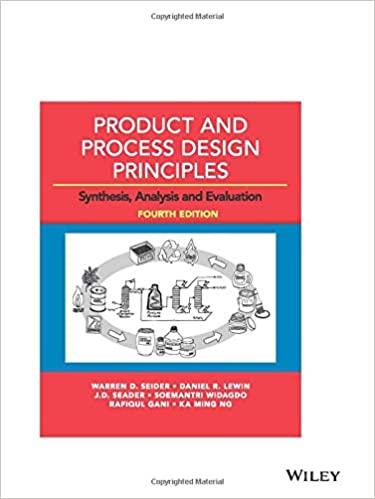Repeat Exercise 8.1, taking the first two reactions as first order, and the last as second order
Question:
Repeat Exercise 8.1, taking the first two reactions as first order, and the last as second order with \(k_{1}=0.02 \mathrm{~min}^{-1}, k_{2}=0.2 \mathrm{~min}^{-1}\), and \(k_{3}=2.0 \mathrm{~L} / \mathrm{mol}-\mathrm{min}\), and the initial concentration of \(C_{\mathrm{A}}=1 \mathrm{~mol} / \mathrm{L}\). Use the attainable region algorithm to find the reactor network that maximizes the selectivity of \(\mathrm{C}\) from \(\mathrm{A}\).
Data From Exercise 8.1:-
A system of three parallel reactions (Trambouze and Piret, 1959) involves the following reaction scheme:
\[\mathrm{A} \xrightarrow{k_{1}} \mathrm{~B} \quad \mathrm{~A} \xrightarrow{k_{2}} \mathrm{C} \quad \mathrm{A} \xrightarrow{k_{3}} \mathrm{D}\]
where the reactions above are zero-order, first-order, and second-order, respectively, with \(k_{1}=0.025 \mathrm{~mol} / \mathrm{L}-\mathrm{min}, \quad k_{2}=0.2 \mathrm{~min}^{-1}\), and \(k_{3}=0.4 \mathrm{~L} / \mathrm{mol}-\mathrm{min}\), and the initial concentration of \(C_{\mathrm{A}}=1 \mathrm{~mol} / \mathrm{L}\). Use the attainable region algorithm to find the reactor network that maximizes the selectivity of \(\mathrm{C}\) from \(\mathrm{A}\).
Step by Step Answer:

Product And Process Design Principles Synthesis Analysis And Evaluation
ISBN: 9781119355243
4th Edition
Authors: Warren D. Seider, Daniel R. Lewin, J. D. Seader, Soemantri Widagdo, Rafiqul Gani, Ka Ming Ng





